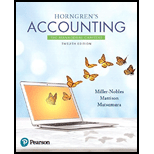
Concept explainers
Concept Introduction:
Differential analysis: Differential analysis is a cost analysis method in which two or more alternative business decisions are compared with each other to find out the best alternative decision. Under this approach, only relevant costs of underlying business decision are take into consideration and suck costs are ignored.
Relevant Cost: Relevant cost is the incremental and inevitable cost that is incurred when making a specific business decision. Relevant cost is useful in eliminating unrequited data that makes decision making process complex.
1.
To Prepare: An analysis report for Cold Sport to decide that company should buy or make the bindings.
2.
To Find: The best profitable alternative out of the alternatives given in the question.
Want to see the full answer?
Check out a sample textbook solution
Chapter 25 Solutions
Horngren's Accounting: The Managerial Chapters (12th Edition) (loose Leaf Version)
- Stevenson Manufacturing is planning to sell 450 storage bins and produce 420 bins during May. Each bin requires 600 grams of metal and 0.75 hours of direct labor. The metal costs $8 per 600 grams, and employees of the company are paid $16.50 per hour. Manufacturing overhead is applied at a rate of 120% of direct labor costs. Stevenson has 250 kilos of metal in the beginning inventory and wants to have 180 kilos in the ending inventory. How much is the total amount of budgeted direct labor cost for May?arrow_forwardprovide correct answerarrow_forwardManagement anticipates fixed costs of $65,000 and variable costs equal to 35% of sales. What will pretax income equal if sales are $320,000? Helparrow_forward
- Before prorating the manufacturing overhead costs at the end of 2016, the Cost of Goods Sold and Finished Goods Inventory had applied overhead costs of $59,700 and $54,000 in them, respectively. There was no Work-in-Process at the beginning or end of 2016. During the year, manufacturing overhead costs of $88,000 were actually incurred. The balance in the Applied Manufacturing Overhead was $94,500 at the end of 2016. If the under-or overapplied overhead is prorated between the Cost of Goods Sold and the inventory accounts, how much will be the Cost of Goods Sold after the proration? (rounded answer)arrow_forwardI want the correct answer with accounting questionarrow_forwardUsing the straight-line methodarrow_forward

 AccountingAccountingISBN:9781337272094Author:WARREN, Carl S., Reeve, James M., Duchac, Jonathan E.Publisher:Cengage Learning,
AccountingAccountingISBN:9781337272094Author:WARREN, Carl S., Reeve, James M., Duchac, Jonathan E.Publisher:Cengage Learning, Accounting Information SystemsAccountingISBN:9781337619202Author:Hall, James A.Publisher:Cengage Learning,
Accounting Information SystemsAccountingISBN:9781337619202Author:Hall, James A.Publisher:Cengage Learning, Horngren's Cost Accounting: A Managerial Emphasis...AccountingISBN:9780134475585Author:Srikant M. Datar, Madhav V. RajanPublisher:PEARSON
Horngren's Cost Accounting: A Managerial Emphasis...AccountingISBN:9780134475585Author:Srikant M. Datar, Madhav V. RajanPublisher:PEARSON Intermediate AccountingAccountingISBN:9781259722660Author:J. David Spiceland, Mark W. Nelson, Wayne M ThomasPublisher:McGraw-Hill Education
Intermediate AccountingAccountingISBN:9781259722660Author:J. David Spiceland, Mark W. Nelson, Wayne M ThomasPublisher:McGraw-Hill Education Financial and Managerial AccountingAccountingISBN:9781259726705Author:John J Wild, Ken W. Shaw, Barbara Chiappetta Fundamental Accounting PrinciplesPublisher:McGraw-Hill Education
Financial and Managerial AccountingAccountingISBN:9781259726705Author:John J Wild, Ken W. Shaw, Barbara Chiappetta Fundamental Accounting PrinciplesPublisher:McGraw-Hill Education





